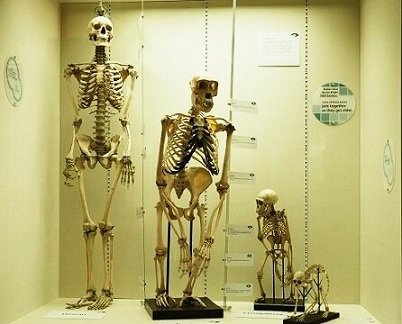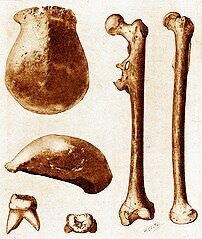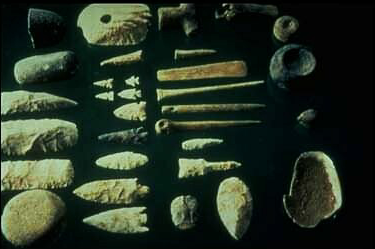Major Breakthroughs In The Trail Of Human Evolution
I'm sure y'all have an idea of what evolution means, at least a vague idea. If not, how did you understand the title of the post? Okay you don't need to worry, just read on. Humans (and other Apes alive today: Chimpanzees, Gorillas, Orangutan etc) have been proven to have shared a common ancestry. What this means is that, evolutionally, we are more or less like cousins with the present day Ape. Here, I won't bother you with the trail of human evolution, but we will focus on the species where major breakthroughs were made in evolution.
INTRODUCTION
The present day humans in this extant form (otherwise referred to as Homo sapiens sapiens) have been uniquely differentiated from our cousin Apes, but you will agree with me that these differences did not just spring forth overnight. Evolution, as we know it, is a rather gradual event that spans through many years. In the case of humans, the first truly recognized ancestor of modern humans; Sahelanthropus; have been carbon-dated to have lived around 7millions years ago. This means that human evolution is also as old as that. However, here, we are concerned with the features that made humans "humans" and the species at which the features were evolved. To make this clearer, we will treat them under the following sub-headings.
- Uprightness in Homo species
- Fashioning of tools
- Cooking delicious meals

1. UPRIGHTNESS IN HOMO SPECIES
Sometimes, people tend to use the term "uprightness" and "bipedalism" interchangeably, but there is an obvious difference between both of them. Bipedalism (as the "bi" and the "pedal" suggest) is the act of walking on just the two feet without using any other body part (like hands) to support locomotion. However, this does not necessarily mean that the species is in a vertical posture. Uprightness means to be erect, to be in a vertical posture while walking. From this, you will agree with me that uprightness is a sub-set of bipedalism. A Hominid species can be bipedal without being upright, but a Hominid species cannot be upright without being bipedal.
Now we have seen the difference, so in which species was the breakthrough of uprightness made? Remember we're talking about uprightness now not bipedalism, because even as far back as 3.9 million years ago, Australopithecus anamensis were known to be bipedal but not upright [ref]. Before I continue, it is worthy to note that evolutionary process of humans from ancient hominid species to this present time was not witnessed by any of us alive today, so to draw inferences, the only pointer at our disposal is "fossil analysis".

According to this research, a particular species was discovered, first, in the Island of Indonesia (Java) and was called "Java man". This species was later called the Homo erectus (or Pithecanthropus erectus). The reason behind this is the fact that the fossils discovered suggested that the species was upright, it had long and relatively straight femur bone, spinal curvature that suggested uprightness and pelvic bone that supports upright posture. More importantly, the height of this species was similar to the average height of the present day humans [ref].
Homo erectus lived around 1.8 million years ago [ref] and marked a major breakthrough in the uprightness of humans ancestors. Obviously, the "erectus" indicates that they were upright. Now, some may ask: what led to or facilitated the evolution of uprightness? The evolution of uprightness can be remotely linked to the evolution of fashioning of tools. Okay let's look at evolution of fashioning and usage of tools in details.

2. FASHIONING OF TOOLS
Making and using of tools has remained one of the distinguishing factors between humans and other species. Even in this our contemporary time, humans have grown in the fashioning of tools that we now see insane technological tools, mind-blowing constructions (like the seven wonders of the world) being made by humans. However, we will look at ancient tool-making; the era of crude stone tools.
Usage of tools came way earlier than fashioning of tools. As a matter of fact, as far back as the era of the Astralopithecus (which was over 3 million years ago), fossil analysis have proven that they made use of tools [ref]. However, they were not known to fashion their own tools; they used some random objects that they found as tools (like branches of trees, stones, bones, etc). Obviously, this does not qualify a species as tool maker.
A particular discovery was made by the legendary Leakeys (Mary Leakey and Louis Leakey) in 1960 at Olduvai Gorge located in East Africa (present day Tanzania). The fossils they discovered, along side them, they also dug out tools that were obviously fashioned by the species [ref1] [ref2], these species were then called Homo habilis - the "habilis" signified that they had the creative ability to fashion tools. And yes! The tools that were discovered have been preserved till this era.

By all inference, the Homo habilis signified a major breakthrough were hominid species picked up tool-making abilities. Reacting to this, another renowned anthropologist; Dr Kenneth Oakley; in the publication, has expressed the fact that one of the unique abilities of man is the making of tools. Well, maybe that's why the species that fashioned the first tools were called "Homo habilis" (man with the tool-making ability, or handy man).
Remember I mentioned earlier that the evolution of uprightness can be remotely linked to the evolution of tool making. Here's the relationship: When man picked up the ability to make tools, he shifted focus from using his hands as support for movement to using them to fashion and use tools. Ultimately, this added to the upright posture of man. It is not surprising that the Homo habilis preceded the Homo erectus. Even though there has not been enough paleontological evidence to show if the Homo habilis evolved directly into Homo erectus or if there were transitional species in-between, but what we know for sure is that handling to tools came before uprightness.
3. COOKING DELICIOUS MEALS
Have you ever seen Chimpanzees or Gorillas eat before? You will agree with me that their major diet revolves around herbs, tree barks, leaves etc. As a human, how will you like your food to be? Okay I know you'd say "well cooked and delicious" - even the vegetarians do not munch green leaves raw. However, at what species of human evolution was the breakthrough of cooking meals made?
Let's rewind to 7million years ago to the time of Sahelanthropus tchadensis (the borderline species between Ape and Ape-men). From fossil analysis, these species were majorly herbivorous and chowed herbs, leaves, etc just like the present day Chimpanzees (but not nuts, because their jaw structure was not massive to support nut cracking) [ref]. Of course, the Sahelanthropus lived in the woods and forest, so they had herbs at their disposal and these herbs made up their diet too.
On progressing up the evolutionary line, about 2 million years ago, a particular species called Zinjanthropus "Paranthropus" boisei, which is also called "nut cracker" started to incorporate nuts into their meals. You will agree with me that nuts have oil and fatty content. This served as a way of preparing man for eating meat. That is, switching from herbivores to meat-eaters.
This is not surprising that the subsequent species, the Australopithecus africanus, according to this research, was discovered to be the first species to incorporate meat into their diet. Obviously, the breakthrough of eating meat is traceable to the Australopithecus africanus. From the same research I referenced above, when men started eating meat, they did not start off as hunters, but they fed off from the remains of already dead animals - more like scavengers. More so, since man, at that time, had not mastered the act of using fire (and cooking food), the meat was obviously eaten raw.. Okay that sucks :(

Some will ask, when did man master the act of using fire? There are limited pointers to which particular species can be traceable to being the first to use fire. However, some discoveries have provided clues to this. For example: some sites where the fossils of the Homo erectus (upright man) were excavated, ashes and fire-related objects were also excavated there; which means that the species obviously used fire [ref].
Remember what I told you that the Homo erectus' hands were freed from locomotion and they had the use of their hands for other purposes. This could also be the reason they had better use of tools than the Homo habilis, which included fire. Some have also linked the discovery of fire to later species like the Cro magnon and the Neanderthals, but since we never witnessed evolution, we are only heavily reliant on fossils to provide answers.
However, even though Homo erectus may have mastered the use of fire, there is no proof whether they passed their food through fire or if they ate them raw like the Australopithecus africanus. But one thing is obvious, the discovery and mastering of fire is the reason you have your deliciously grilled and barbecued meat today.
FINAL WORDS
Humans have been recognized as one of the most successfully evolved and adapted species, and this can be proven by the dominance and supremacy they have shown over other species. There are many features that have given man his uniqueness among all other hominid and hominins, but these features were evolved over time and through millions of years. We have tried to take a survey of the species that marked major breakthroughs in the evolution of man. One very important point I will like to drop here for y'all is; we should not expect evolution to stop with humans. Species are constantly evolving, but at a very slow pace.
> References for further reading
- Bipedalism in Australopithecus
- Introduction of fire in human evolution
- Tool making in Hominds
- Early species of hominid
- Homo habilis and their creative abilities of tool making
- Extincts Hominids
- Uprightness in Homo erectus


gif by @foundation
Congratulations @samminator! You have completed the following achievement on the Steem blockchain and have been rewarded with new badge(s) :
You can view your badges on your Steem Board and compare to others on the Steem Ranking
If you no longer want to receive notifications, reply to this comment with the word
STOPTo support your work, I also upvoted your post!
Vote for @Steemitboard as a witness to get one more award and increased upvotes!
Some authors consider that instead of omnivores, humans should be classified as cucinivores (https://doi.org/10.2527/jas.2014-8481).
I'm not actually concerned about classifying humans as either omnivores or cucinivores (everyone has their own school of thought). I only focused on the species where there was a divergence from the herbivorous lifestyle of the ancestors of modern man.
Thanks for coming around, for the reference you provided and the Resteem
This post has been voted on by the SteemSTEM curation team and voting trail. It is elligible for support from @curie and @minnowbooster.
If you appreciate the work we are doing, then consider supporting our witness @stem.witness. Additional witness support to the curie witness would be appreciated as well.
For additional information please join us on the SteemSTEM discord and to get to know the rest of the community!
Thanks for having used the steemstem.io app and included @steemstem in the list of beneficiaries of this post. This granted you a stronger support from SteemSTEM.
Is it credible that there are different subspecies of humans if you discard ideology and use the same standards that are used for other animals?
Although it makes sense to associate the evolution of tool-making with the uprightness process seen in humans, I had never linked the two before! I so like how you make your posts on evolution such an easy-read, but at the same time pack them with lots of info Sammi :)
Another curious info I learnt from your post was that humans started their meat eating habits like scavengers! I was aware that when we became carnivores we first ate raw meat, but never really thought of our ancestors eating the left-overs of other species' kills.
Thank you for providing us with a such pleasant, interesting read Sammi.
Much love from sunny, cool Portugal :*
I'm so glad you found the post interesting. Evolution, no doubt, is one of the most theorized aspects of science, the reasons being that we didn't witness it first-hand. This is why the greater knowledge of evolution we have is from fossil record.
My mum once told me that three sources of history exist: Oral tradition, written record, and archaeology (which includes paleontology - fossil study).. She's a historian.
So basically, the views represented here is a systematic review of researches from evolutionary scientists.
Thanks for coming around dear Abbey. Much love always from rainy Nigeria